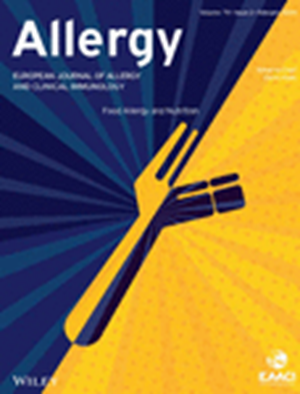ILC2s在变应性气道疾病中的扩展作用
IF 12
1区 医学
Q1 ALLERGY
引用次数: 0
摘要
2组先天淋巴样细胞(ILC2s)在变应性气道疾病的发生和传播中起关键作用。这些细胞在15年前首次被发现,它们以非抗原依赖的方式对一系列刺激作出反应。ILC2s产生大量的细胞因子,包括IL - 5和IL - 13,这在过敏性哮喘的发病机制中至关重要。虽然过敏性气道疾病一直被认为是T -辅助性2细胞驱动的疾病,但即使在缺乏适应性免疫系统的情况下,ILC2s也能够在小鼠中诱导过敏型病理。ILC2s在推动过敏性气道疾病病理中的作用仍然是一个不断扩大的知识领域,可能为哮喘管理提供新的治疗方法,哮喘是一种影响全球多达3亿人的疾病。在这篇综述中,我们回顾了目前ILC2免疫生物学的知识,概述了ILC2表型,同时对ILC2可塑性的见解,并探讨了共刺激分子、神经内分泌信号和饮食来源的营养物质在调节ILC2活性中的作用。本文章由计算机程序翻译,如有差异,请以英文原文为准。
The Expanding Role of ILC2s in Allergic Airways Disease
Group 2 innate lymphoid cells (ILC2s) play a pivotal role in the initiation and propagation of allergic airways disease. These cells, first discovered 15 years ago, respond to a range of stimuli in a non‐antigen‐dependent manner. ILC2s produce copious amounts of cytokines including IL‐5 and IL‐13, which are critical in the pathogenesis of allergic asthma. While allergic airways diseases have long been considered T‐helper 2 cell‐driven diseases, ILC2s are capable of inducing allergic‐type pathologies in mice even in the absence of the adaptive immune system. The role of ILC2s in driving the pathology of allergic airways disease remains an expanding field of knowledge that may unlock novel therapeutic approaches in the management of asthma, a disease that affects up to 300 million people worldwide. In this review, we survey current knowledge of ILC2 immunobiology and present an overview of ILC2 phenotyping, concurrent with insights into ILC2 plasticity, and an exploration of the roles of costimulatory molecules, neuroendocrine signals, and diet‐derived nutrients in modulating ILC2 activity.
求助全文
通过发布文献求助,成功后即可免费获取论文全文。
去求助
来源期刊

Allergy
医学-过敏
CiteScore
26.10
自引率
9.70%
发文量
393
审稿时长
2 months
期刊介绍:
Allergy is an international and multidisciplinary journal that aims to advance, impact, and communicate all aspects of the discipline of Allergy/Immunology. It publishes original articles, reviews, position papers, guidelines, editorials, news and commentaries, letters to the editors, and correspondences. The journal accepts articles based on their scientific merit and quality.
Allergy seeks to maintain contact between basic and clinical Allergy/Immunology and encourages contributions from contributors and readers from all countries. In addition to its publication, Allergy also provides abstracting and indexing information. Some of the databases that include Allergy abstracts are Abstracts on Hygiene & Communicable Disease, Academic Search Alumni Edition, AgBiotech News & Information, AGRICOLA Database, Biological Abstracts, PubMed Dietary Supplement Subset, and Global Health, among others.
 求助内容:
求助内容: 应助结果提醒方式:
应助结果提醒方式:


